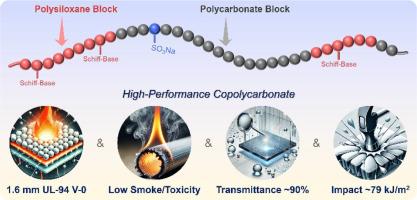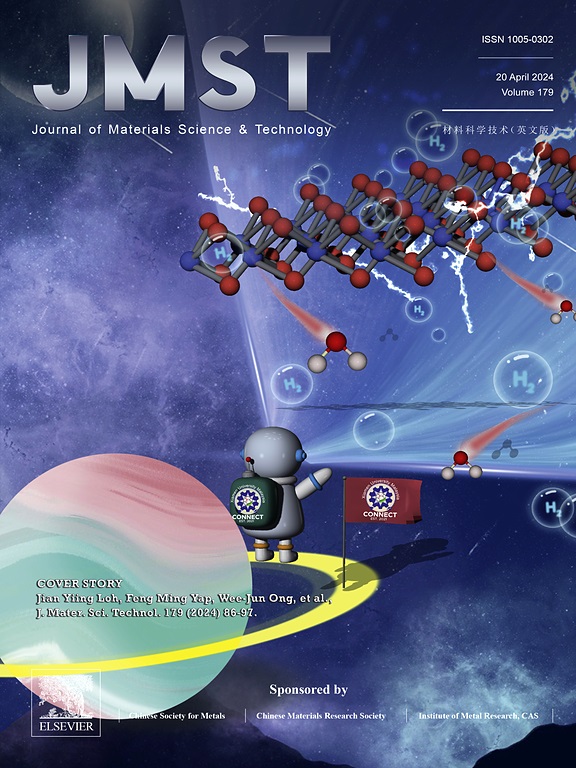Transparent, intrinsically fire-safe yet impact-resistant poly(carbonates-b-siloxanes) containing Schiff-base and naphthalene-sulfonate
IF 11.2
1区 材料科学
Q1 MATERIALS SCIENCE, MULTIDISCIPLINARY
引用次数: 0
Abstract
A series of transparent, intrinsically flame-retardant, and impact-resistant poly(carbonates-b-siloxanes) were synthesized by incorporating Schiff-base modified polysiloxanes (DMS-Schiff) and naphthalene-sulfonate units into the polycarbonate (PC) chain. In addition to high transparency, the resultant copolymers (SS-co-PC5, SS-co-PC9, SS-co-PC14, and SS-co-PC20) exhibited remarkable improvements in fire safety and mechanical performance. Compared to pure PC, these copolymers demonstrated significantly enhanced limiting oxygen index (LOI, up to 34.5%) and a UL-94 V-0 rating under a thickness of only 1.6 mm. The incorporation of the polysiloxane blocks not only improved flame retardancy but also enhanced the impact strength, with SS-co-PC9 showing a 48% increase in elongation at break and a 38% rise in impact toughness compared to pure PC. In addition, SS-co-PC9 presented high mechanical strength. The synergistic effects between the naphthalene-sulfonate and polysiloxane blocks, along with the well-controlled polysiloxane phase separation (sulfonate units enabled lower processing viscosity of copolymers), led to superior comprehensive performance. These findings provide a promising pathway to create high-performance copolycarbonates for real-world applications.

透明,本质上是防火的,但耐冲击的聚(碳酸盐-b-硅氧烷)含有希夫碱和萘磺酸盐
通过在聚碳酸酯(PC)链中加入席夫碱修饰的聚硅氧烷(DMS-Schiff)和萘磺酸单元,合成了一系列透明、本征阻燃和抗冲击的聚(碳酸盐-b-硅氧烷)。除了高透明度之外,这些共聚物(SS-co-PC5、SS-co-PC9、SS-co-PC14 和 SS-co-PC20)在防火安全性和机械性能方面也有显著改善。与纯 PC 相比,这些共聚物的极限氧指数(LOI,高达 34.5%)显著提高,在厚度仅为 1.6 毫米的情况下,达到了 UL-94 V-0 等级。与纯 PC 相比,SS-co-PC9 的断裂伸长率提高了 48%,冲击韧性提高了 38%。此外,SS-co-PC9 还具有很高的机械强度。萘磺酸盐和聚硅氧烷嵌段之间的协同效应,以及良好控制的聚硅氧烷相分离(磺酸盐单元可降低共聚物的加工粘度),使得共聚物具有卓越的综合性能。这些发现为制造高性能共聚碳酸酯的实际应用提供了一条前景广阔的途径。
本文章由计算机程序翻译,如有差异,请以英文原文为准。
求助全文
约1分钟内获得全文
求助全文
来源期刊

Journal of Materials Science & Technology
工程技术-材料科学:综合
CiteScore
20.00
自引率
11.00%
发文量
995
审稿时长
13 days
期刊介绍:
Journal of Materials Science & Technology strives to promote global collaboration in the field of materials science and technology. It primarily publishes original research papers, invited review articles, letters, research notes, and summaries of scientific achievements. The journal covers a wide range of materials science and technology topics, including metallic materials, inorganic nonmetallic materials, and composite materials.
文献相关原料
公司名称
产品信息
阿拉丁
bisphenol A (BPA)
阿拉丁
benzaldehyde
阿拉丁
3-aminopropylmethyldiethoxysilane (APS)
阿拉丁
Octamethylcyclotetrasiloxane (D4)
阿拉丁
bisphenol A (BPA)
阿拉丁
benzaldehyde
阿拉丁
3-aminopropylmethyldiethoxysilane (APS)
阿拉丁
Octamethylcyclotetrasiloxane (D4)
 求助内容:
求助内容: 应助结果提醒方式:
应助结果提醒方式:


